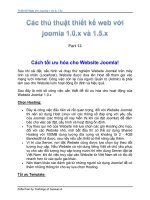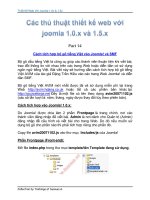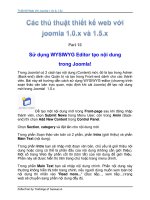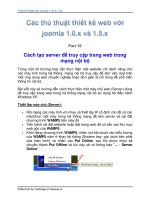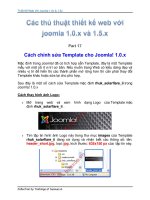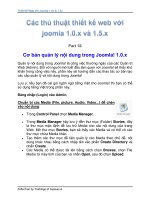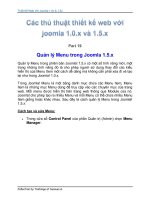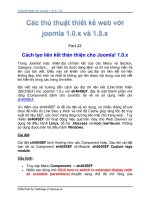Tài liệu CSS trong thiết kế web docx
Bạn đang xem bản rút gọn của tài liệu. Xem và tải ngay bản đầy đủ của tài liệu tại đây (12.49 MB, 385 trang )
CSS Web Design
FOR
DUMmIES
‰
01_584251 ffirs.qxd 2/10/05 11:01 PM Page i
TEAM LinG - Live, Informative, Non-cost and Genuine !
01_584251 ffirs.qxd 2/10/05 11:01 PM Page ii
TEAM LinG - Live, Informative, Non-cost and Genuine !
by Richard Mansfield
CSS Web Design
FOR
DUMmIES
‰
01_584251 ffirs.qxd 2/10/05 11:01 PM Page iii
TEAM LinG - Live, Informative, Non-cost and Genuine !
CSS Web Design For Dummies
®
Published by
Wiley Publishing, Inc.
111 River Street
Hoboken, NJ 07030-5774
www.wiley.com
Copyright © 2005 by Wiley Publishing, Inc., Indianapolis, Indiana
Published by Wiley Publishing, Inc., Indianapolis, Indiana
Published simultaneously in Canada
No part of this publication may be reproduced, stored in a retrieval system or transmitted in any form or by
any means, electronic, mechanical, photocopying, recording, scanning or otherwise, except as permitted
under Sections 107 or 108 of the 1976 United States Copyright Act, without either the prior written permis-
sion of the Publisher, or authorization through payment of the appropriate per-copy fee to the Copyright
Clearance Center, 222 Rosewood Drive, Danvers, MA 01923, (978) 750-8400, fax (978) 646-8600. Requests to
the Publisher for permission should be addressed to the Legal Department, Wiley Publishing, Inc., 10475
Crosspoint Blvd., Indianapolis, IN 46256, (317) 572-3447, fax (317) 572-4355, e-mail:
.
Trademarks: Wiley, the Wiley Publishing logo, For Dummies, the Dummies Man logo, A Reference for the
Rest of Us!, The Dummies Way, Dummies Daily, The Fun and Easy Way, Dummies.com, and related trade
dress are trademarks or registered trademarks of John Wiley & Sons, Inc. and/or its affiliates in the United
States and other countries, and may not be used without written permission. All other trademarks are the
property of their respective owners. Wiley Publishing, Inc., is not associated with any product or vendor
mentioned in this book.
LIMIT OF LIABILITY/DISCLAIMER OF WARRANTY: THE PUBLISHER AND THE AUTHOR MAKE NO REP-
RESENTATIONS OR WARRANTIES WITH RESPECT TO THE ACCURACY OR COMPLETENESS OF THE CON-
TENTS OF THIS WORK AND SPECIFICALLY DISCLAIM ALL WARRANTIES, INCLUDING WITHOUT
LIMITATION WARRANTIES OF FITNESS FOR A PARTICULAR PURPOSE. NO WARRANTY MAY BE CRE-
ATED OR EXTENDED BY SALES OR PROMOTIONAL MATERIALS. THE ADVICE AND STRATEGIES CON-
TAINED HEREIN MAY NOT BE SUITABLE FOR EVERY SITUATION. THIS WORK IS SOLD WITH THE
UNDERSTANDING THAT THE PUBLISHER IS NOT ENGAGED IN RENDERING LEGAL, ACCOUNTING, OR
OTHER PROFESSIONAL SERVICES. IF PROFESSIONAL ASSISTANCE IS REQUIRED, THE SERVICES OF A
COMPETENT PROFESSIONAL PERSON SHOULD BE SOUGHT. NEITHER THE PUBLISHER NOR THE
AUTHOR SHALL BE LIABLE FOR DAMAGES ARISING HEREFROM. THE FACT THAT AN ORGANIZATION
OR WEBSITE IS REFERRED TO IN THIS WORK AS A CITATION AND/OR A POTENTIAL SOURCE OF FUR-
THER INFORMATION DOES NOT MEAN THAT THE AUTHOR OR THE PUBLISHER ENDORSES THE INFOR-
MATION THE ORGANIZATION OR WEBSITE MAY PROVIDE OR RECOMMENDATIONS IT MAY MAKE.
FURTHER, READERS SHOULD BE AWARE THAT INTERNET WEBSITES LISTED IN THIS WORK MAY HAVE
CHANGED OR DISAPPEARED BETWEEN WHEN THIS WORK WAS WRITTEN AND WHEN IT IS READ.
For general information on our other products and services, please contact our Customer Care
Department within the U.S. at 800-762-2974, outside the U.S. at 317-572-3993, or fax 317-572-4002.
For technical support, please visit
www.wiley.com/techsupport
.
Wiley also publishes its books in a variety of electronic formats. Some content that appears in print may
not be available in electronic books.
Library of Congress Control Number: 2005920081
ISBN: 0-7645-8425-1
Manufactured in the United States of America
10987654321
1O/QS/QT/QV/IN
01_584251 ffirs.qxd 2/10/05 11:01 PM Page iv
TEAM LinG - Live, Informative, Non-cost and Genuine !
About the Author
Richard Mansfield was the editor of COMPUTE! Magazine from 1981 to 1987.
During that time, he wrote hundreds of magazine articles and two columns.
From 1987 to 1991, he was editorial director and partner at Signal Research.
He began writing books full-time in 1991 and has written 36 computer books
since 1982. Of those, four became bestsellers: Machine Language for Beginners
(COMPUTE! Books), The Second Book of Machine Language (COMPUTE!
Books), The Visual Guide to Visual Basic (Ventana), and The Visual Basic
Power Toolkit (Ventana, coauthored by Evangelos Petroutsos). His books
combined have sold more than 500,000 copies worldwide and have been
translated into 12 languages.
Richard’s recent titles include Office 2003 Application Development All-in-One
Desk Reference For Dummies, Visual Basic .NET All-in-One Desk Reference
For Dummies, Visual Basic .NET Weekend Crash Course, Visual Basic .NET
Database Programming For Dummies, Visual Basic 6 Database Programming
For Dummies (all published by Wiley), Hacker Attack (Sybex), and The Wi-Fi
Experience: Everyone’s Guide to 802.11b Wireless Networking (Pearson
Education, coauthored by Harold Davis).
01_584251 ffirs.qxd 2/10/05 11:01 PM Page v
TEAM LinG - Live, Informative, Non-cost and Genuine !
01_584251 ffirs.qxd 2/10/05 11:01 PM Page vi
TEAM LinG - Live, Informative, Non-cost and Genuine !
Dedication
This book is dedicated to David Lee Roach.
Author’s Acknowledgments
I want to thank acquisitions editor Katie Feltman for her thoughtful and help-
ful advice. I’ve worked with Katie before, and she knows her stuff. I was also
lucky to have two strong editors improve this book. Project editor Linda
Morris asks the right questions, makes lots of good suggestions, and overall
stands in as a representative of the reader. She requests clarification when
necessary, and ensures that the reader will find consistent, useful informa-
tion. She deserves credit for her taste and the high quality of her editing.
The technical editor, Vanessa Williams, reviewed the entire manuscript for
technical quality. For that I thank her. I’m happy to report that she found few
flaws in the programming code, but I’m certainly glad to have an opportunity
to fix the few flaws she did spot. Vanessa also suggested alternative CSS tech-
niques and additional resources, deepening the technical information avail-
able in the book.
To these, and all the other good people at Wiley who contributed to the book,
my thanks for the time and care they took to ensure quality every step along
the way to publication.
01_584251 ffirs.qxd 2/10/05 11:01 PM Page vii
TEAM LinG - Live, Informative, Non-cost and Genuine !
Publisher’s Acknowledgments
We’re proud of this book; please send us your comments through our online registration form
located at
www.dummies.com/register/
.
Some of the people who helped bring this book to market include the following:
Acquisitions, Editorial, and
Media Development
Project Editor: Linda Morris
Acquisitions Editor: Katie Feltman
Copy Editor: Linda Morris
Technical Editor: Vanessa Williams
Editorial Manager: Carol Sheehan
Media Development Manager:
Laura VanWinkle
Media Development Supervisor:
Richard Graves
Editorial Assistant: Amanda Foxworth
Cartoons: Rich Tennant
(
www.the5thwave.com
)
Composition Services
Project Coordinator: Adrienne Martinez
Layout and Graphics: Carl Byers, Andrea Dahl,
Lauren Goddard, Joyce Haughey,
Stephanie D. Jumper, Melanee Prendergast
Proofreaders: Leeann Harney, Jessica Kramer
Indexer: TECHBOOKS Production Services
Publishing and Editorial for Technology Dummies
Richard Swadley, Vice President and Executive Group Publisher
Andy Cummings, Vice President and Publisher
Mary Bednarek, Executive Acquisitions Director
Mary C. Corder, Editorial Director
Publishing for Consumer Dummies
Diane Graves Steele, Vice President and Publisher
Joyce Pepple, Acquisitions Director
Composition Services
Gerry Fahey, Vice President of Production Services
Debbie Stailey, Director of Composition Services
01_584251 ffirs.qxd 2/10/05 11:01 PM Page viii
TEAM LinG - Live, Informative, Non-cost and Genuine !
Contents at a Glance
Introduction ................................................................1
Part I: The ABCs of CSS .............................................13
Chapter 1: CSS Fulfills a Promise ...................................................................................15
Chapter 2: Getting Results with CSS ............................................................................31
Chapter 3: Up and Running with Selectors ..................................................................47
Part II: Looking Good with CSS ...................................67
Chapter 4: Taking a Position ..........................................................................................69
Chapter 5: All About Text ..............................................................................................85
Chapter 6: Managing Details in Style Sheets ..............................................................107
Chapter 7: Styling It Your Way .....................................................................................127
Part III: Adding Artistry: Design and Composition
with CSS .................................................................153
Chapter 8: Web Design Basics ......................................................................................155
Chapter 9: Spacing Out with Boxes .............................................................................169
Chapter 10: Organizing Your Web Pages Visually ....................................................183
Chapter 11: Designing with Auto and Inline Elements ..............................................197
Chapter 12: Handling Tables and Lists
(And Doing Away with Tables) ..................................................................................207
Chapter 13: Creating Dramatic Visual Effects ............................................................233
Part IV: Advanced CSS Techniques ............................251
Chapter 14: Specializing in Selection ..........................................................................253
Chapter 15: CSS Moves into the Future ......................................................................265
Chapter 16: Programmatic CSS ....................................................................................279
Chapter 17: Testing and Debugging ............................................................................297
Part V: The Part of Tens ...........................................317
Chapter 18: Ten Great CSS Tips and Tricks ................................................................319
Chapter 19: Ten Topics That Don’t Fit Elsewhere in the Book
(But Are Important) ....................................................................................................329
Index .......................................................................339
02_584251 ftoc.qxd 2/10/05 11:06 PM Page ix
TEAM LinG - Live, Informative, Non-cost and Genuine !
02_584251 ftoc.qxd 2/10/05 11:06 PM Page x
TEAM LinG - Live, Informative, Non-cost and Genuine !
Table of Contents
Introduction..................................................................1
Creating Compelling Designs .........................................................................1
Separating Content from Style .......................................................................1
Benefiting from the Cascade ..........................................................................2
The End of the Browser Wars ........................................................................3
Who Should Read This Book .........................................................................4
For designers, would-be designers, programmers,
and developers alike .........................................................................5
Making do in a shaky economy ...........................................................5
Plain, Clear English .........................................................................................6
How to Use This Book ....................................................................................6
Foolish Assumptions ......................................................................................7
How This Book Is Organized ..........................................................................8
Part I: The ABCs of CSS .........................................................................8
Part II: Looking Good with CSS ............................................................9
Part III: Adding Artistry: Design and Composition with CSS ............9
Part IV: Advanced CSS Techniques ...................................................10
Part V: The Part of Tens ......................................................................10
Conventions Used in This Book ..................................................................11
Special symbols ...................................................................................11
Avoid typos: find all the code online ................................................12
What you need to get started ............................................................12
Icons used in this book .......................................................................12
Part I: The ABCs of CSS ..............................................13
Chapter 1: CSS Fulfills a Promise . . . . . . . . . . . . . . . . . . . . . . . . . . . . . .15
Improving HTML ...........................................................................................15
Getting Efficient with CSS .............................................................................17
Changing Web design for the better .................................................17
Being ready for anything ....................................................................18
Designers Want to Design ............................................................................20
Where CSS Fits with the Tools You Already Use .......................................22
Getting Practical ............................................................................................24
Look for CSS features in your current software ..............................24
Resources on the Web ........................................................................24
Avoiding Browser Compatibility Problems ................................................25
Getting Dramatic with Filters .......................................................................26
02_584251 ftoc.qxd 2/10/05 11:06 PM Page xi
TEAM LinG - Live, Informative, Non-cost and Genuine !
Chapter 2: Getting Results with CSS . . . . . . . . . . . . . . . . . . . . . . . . . . .31
Starting from Scratch ....................................................................................31
Selectors and Such: CSS Syntax ...................................................................33
Properties refer to attributes .............................................................34
Grouping ...............................................................................................35
Showing Some Class .....................................................................................35
Specifying All-Purpose Properties ..............................................................37
Using an ID Selector ......................................................................................38
Specifying more than one class .........................................................40
Capitalizing on case-sensitivity .........................................................40
Just stay in lowercase .........................................................................41
When Styles Cascade ....................................................................................41
Visualizing specificity .........................................................................41
Understanding CSS specificity ...........................................................43
Grasping Inheritance ....................................................................................45
Chapter 3: Up and Running with Selectors . . . . . . . . . . . . . . . . . . . . . .47
Working with Universal Selectors ...............................................................48
Using Multiple Declarations .........................................................................49
Using Attributes as Selectors ......................................................................50
The Simplest Attribute Selector ..................................................................52
Matching attribute selection types ...................................................53
Matching partial attribute values ......................................................53
Matching exact attribute values ........................................................54
Building Your First Style Sheet ....................................................................54
Transforming a Word document into a Web page ...........................55
Visualizing levels of specificity ..........................................................57
Creating an External Cascading Style Sheet ..............................................59
The importance of !Important ...........................................................60
The importance of being closest .......................................................62
Omit semicolons ..................................................................................62
Everything must be important ..........................................................62
Adding New Selectors ...................................................................................63
When Cascades Collide ................................................................................64
Part II: Looking Good with CSS ...................................67
Chapter 4: Taking a Position . . . . . . . . . . . . . . . . . . . . . . . . . . . . . . . . . . .69
Relativity Explained ......................................................................................72
Flow Versus Positioning, Floating Versus Coordinates ............................73
Controlling Layout with Offsetting .............................................................76
Moving Deeper into Positioning ..................................................................79
Stacking Elements on Top of Each Other with the Z-Axis ........................81
Combining Stacking with Translucence .....................................................82
CSS Web Design For Dummies
xii
02_584251 ftoc.qxd 2/10/05 11:06 PM Page xii
TEAM LinG - Live, Informative, Non-cost and Genuine !
Chapter 5: All About Text . . . . . . . . . . . . . . . . . . . . . . . . . . . . . . . . . . . . .85
Thinking About User Interfaces ..................................................................85
Substituting Fonts .........................................................................................86
Types of Type ................................................................................................87
Avoiding monospace ...........................................................................90
Using system styles .............................................................................91
All Roads Lead to Rome ...............................................................................92
Simplicity above all .............................................................................92
When you’re not too picky about typeface .....................................94
Using Font Variants .......................................................................................94
Specifying Font Weight .................................................................................95
Using the Font-Variant for Small Caps ........................................................96
Simple Font-Style ...........................................................................................96
Choosing the Right Typeface Size ...............................................................97
Specifying relative sizes ......................................................................97
Controlling font size with greater precision ....................................98
Specifying Absolute Measured Sizes ..........................................................99
Font: The All-Purpose Property .................................................................100
Adjusting Line Height .................................................................................101
Decorating Text with Underlining and Strikethrough ............................103
Transforming Text with Capitalization .....................................................104
Shading with Drop-Shadowing ...................................................................105
Chapter 6: Managing Details in Style Sheets . . . . . . . . . . . . . . . . . . .107
Specifying Size and Position ......................................................................107
Measuring length ...............................................................................108
Understanding little em ....................................................................109
Figuring the Percentages ............................................................................111
Adding a Bit of Color ...................................................................................113
Creating special paragraph styles ...................................................115
Calculating color ...............................................................................115
Using the color list ............................................................................116
Coloring borders ...............................................................................118
Using inset border colors .................................................................119
Where does light come from? ..........................................................121
Coloring the Background ...........................................................................123
Chapter 7: Styling It Your Way . . . . . . . . . . . . . . . . . . . . . . . . . . . . . . . .127
Kerning for Better Headlines .....................................................................127
True kerning .......................................................................................129
Ultra kerning ......................................................................................131
Vertical Tightening ......................................................................................133
Adjusting percentages ......................................................................133
Understanding baselines ..................................................................135
CSS3 Introduces Kerning Mode .................................................................135
xiii
Table of Contents
02_584251 ftoc.qxd 2/10/05 11:06 PM Page xiii
TEAM LinG - Live, Informative, Non-cost and Genuine !
Word spacing ...............................................................................................135
Aligning Text ................................................................................................138
Vertical aligning .................................................................................138
Using descriptive values ..................................................................139
Aligning by percentages ...................................................................140
Horizontal Alignment ..................................................................................141
Indenting Text ..............................................................................................142
Texturing ......................................................................................................143
Setting Individual Background Properties ...............................................147
No background inheritance ..............................................................148
Special repeats ...................................................................................148
Background Positioning .............................................................................149
Part III: Adding Artistry: Design and
Composition with CSS ...............................................153
Chapter 8: Web Design Basics . . . . . . . . . . . . . . . . . . . . . . . . . . . . . . . .155
Organizing with White Space .....................................................................156
Take a second look ............................................................................156
Getting on balance ............................................................................156
Emphasizing an Object with Silhouetting ................................................159
Adding Drop Caps .......................................................................................160
Trapping White Space ................................................................................163
Following the Rule of Thirds ......................................................................164
The four hot spots .............................................................................165
Background image positioning ........................................................166
Keeping It Appropriate ...............................................................................168
Chapter 9: Spacing Out with Boxes . . . . . . . . . . . . . . . . . . . . . . . . . . .169
Getting a Grip on Boxes ..............................................................................169
Adding a border .................................................................................171
Adding padding .................................................................................171
Adding a margin .................................................................................172
Vertical Positioning .....................................................................................173
Horizontal Positioning ................................................................................176
Breaking Up Text with Horizontal Lines ...................................................178
Chapter 10: Organizing Your Web Pages Visually . . . . . . . . . . . . . . .183
Managing Borders .......................................................................................184
Specifying a simple border ...............................................................184
Choosing from lotsa border styles ..................................................186
Mixing and matching styles .............................................................188
Specifying border width ...................................................................189
Coloring a border ..............................................................................190
CSS Web Design For Dummies
xiv
02_584251 ftoc.qxd 2/10/05 11:06 PM Page xiv
TEAM LinG - Live, Informative, Non-cost and Genuine !
Floating About .............................................................................................191
Canceling a Float with Clear ......................................................................194
Chapter 11: Designing with Auto and Inline Elements . . . . . . . . . . .197
Employing Auto to Control Layout ...........................................................197
Specifying margins ............................................................................200
Centering ............................................................................................201
Using !DOCTYPE to force IE to comply ...........................................201
Vertical Positioning with Auto ...................................................................202
Handling Inline Elements ............................................................................203
Chapter 12: Handling Tables and Lists (And Doing
Away with Tables) . . . . . . . . . . . . . . . . . . . . . . . . . . . . . . . . . . . . . . . . . .207
List Styles O’ Plenty ....................................................................................208
Getting exotic with the list-style-image property ..........................210
Positioning lists .................................................................................211
Putting it all together ........................................................................213
Managing Tables ..........................................................................................213
Stalking invisible .gifs ........................................................................213
Employing the table-layout property .............................................214
Avoiding properties not supported by IE .......................................216
Doing Without Tables .................................................................................216
Positioning where you will ...............................................................217
Placing content willy-nilly ................................................................217
Loving your layout a little too much ...............................................222
Creating Columns that Resize with the Browser .....................................224
Building Fixed Columns ..............................................................................228
Chapter 13: Creating Dramatic Visual Effects . . . . . . . . . . . . . . . . . . .233
Impressing with Static Filters ...................................................................234
Dazzling with Transition Filters ................................................................238
Fading Between Images ..............................................................................243
Transitions between Pages ........................................................................246
Part IV: Advanced CSS Techniques ............................251
Chapter 14: Specializing in Selection . . . . . . . . . . . . . . . . . . . . . . . . . .253
Getting Specific with Inheritance ..............................................................253
Grasping tree structure ....................................................................254
Parents versus ancestors .................................................................254
When a root sits above the tree ......................................................255
The shaky tree ...................................................................................256
Offspring Inheriting .....................................................................................257
xv
Table of Contents
02_584251 ftoc.qxd 2/10/05 11:06 PM Page xv
TEAM LinG - Live, Informative, Non-cost and Genuine !
Contextual Selectors ...................................................................................257
Selecting by context rather than grouping ....................................258
Descending deeper ............................................................................261
Styling distant descendants .............................................................262
Thwarting Descendant Selectors ..............................................................263
Selectors Using Attributes .........................................................................264
Chapter 15: CSS Moves into the Future . . . . . . . . . . . . . . . . . . . . . . . .265
Getting to Know CSS3 .................................................................................265
Working with Mozilla-supported CSS3 features .............................266
Setting opacity ...................................................................................268
Discovering False Pseudo-Classes ............................................................269
Hyperlink formatting with pseudo-classes ....................................270
Hovering with pseudo-classes .........................................................272
Adding your own class name to a pseudo-class ............................272
Selecting first children ......................................................................273
Employing Fake Pseudo-Elements ............................................................273
Creating quick drop caps with first-letter ......................................274
Using the first-line element for special lines of text ......................275
The Future of Pseudo .................................................................................275
Enabling, disabling ............................................................................276
Checking radio buttons and check boxes ......................................276
Figuring Out Dubious Descendant Selectors ...........................................277
Chapter 16: Programmatic CSS . . . . . . . . . . . . . . . . . . . . . . . . . . . . . . .279
Extending CSS with Scripting .....................................................................279
Executing Scripts Automatically upon Loading ......................................282
Using the Right Tools for the Job ..............................................................283
Modifying CSS Styles through Programming ...........................................284
Changing styles ..................................................................................284
Changing the rules ............................................................................288
Timing Things Right ....................................................................................290
Grasping countdown timers ............................................................293
Employing metronome timers .........................................................294
Chapter 17: Testing and Debugging . . . . . . . . . . . . . . . . . . . . . . . . . . . .297
Checking Punctuation .................................................................................297
Validating Your Work ..................................................................................300
Ignoring Fringe Browsers ...........................................................................301
Going back in time .............................................................................301
What if you must consider compatibility? .....................................301
Checking compatibility charts .........................................................302
Sniffing browsers ...............................................................................302
Forcing users to upgrade ..................................................................303
CSS Web Design For Dummies
xvi
02_584251 ftoc.qxd 2/10/05 11:06 PM Page xvi
TEAM LinG - Live, Informative, Non-cost and Genuine !
Trying Out the W3C Validator ...................................................................304
Hoping for helpful error messages ..................................................307
Identifying property value problems ..............................................308
Validating HTML ..........................................................................................309
Meeting some requirements ............................................................310
Finding a better bug trap ..................................................................314
Debugging Script .........................................................................................315
Part V: The Part of Tens ............................................317
Chapter 18: Ten Great CSS Tips and Tricks . . . . . . . . . . . . . . . . . . . . .319
Letting Users Control Font Size .................................................................319
Making Sure Your Borders Show Up .........................................................320
Watching Out for Color Clash ....................................................................320
Centering for Everyone ..............................................................................320
Timing Blurring and Other Effects ............................................................321
Debugging Script .........................................................................................323
Finding a List Apart (Get It?) .....................................................................324
Using Your Own Bullets in Lists ................................................................324
Specifying Graphics Locations ..................................................................325
Combining Classes ......................................................................................326
Aunt Mildred’s Glazed Carrots ..................................................................327
Chapter 19: Ten Topics That Don’t Fit Elsewhere in the Book
(But Are Important) . . . . . . . . . . . . . . . . . . . . . . . . . . . . . . . . . . . . . . . . . .329
Keeping Current via the Internet ...............................................................330
Upgrading HTML Web Pages to CSS .........................................................330
Finding Good Tutorials and Reference Information ...............................330
Remembering Inheritance ..........................................................................331
The SelectORacle: Getting Explanations About Complicated Rules ....332
Providing Alternatives ................................................................................332
Letting the User Decide ..............................................................................333
Exploring Visual Studio ..............................................................................335
Rediscovering Columns ..............................................................................336
Playing with Positions ................................................................................337
Index........................................................................339
xvii
Table of Contents
02_584251 ftoc.qxd 2/10/05 11:06 PM Page xvii
TEAM LinG - Live, Informative, Non-cost and Genuine !
CSS Web Design For Dummies
xviii
02_584251 ftoc.qxd 2/10/05 11:06 PM Page xviii
TEAM LinG - Live, Informative, Non-cost and Genuine !
Introduction
W
elcome to the world of Cascading Style Sheets (CSS). With CSS, you
can design gorgeous and highly effective Web sites. CSS offers power
and flexibility to Web site developers and designers. This book shows you
how to use CSS to make your Web pages come alive.
Marketing experts like to say that the box helps sell the jewelry. CSS does
several useful things, but one of the most important is to help you design
much more attractive packages to hold your Web page contents.
Creating Compelling Designs
CSS allows you to separate presentation from content when building a Web
site. Put another way, HTML itself is rather limited in what it can effectively
display. It’s fine for holding or describing content (such as a paragraph of
text), but the appearance of raw HTML Web pages isn’t very stylish (to put
it kindly).
With HTML, you often can’t find an easy way — or any way at all — to display
the content so that it looks really good when someone views it in a browser.
Using CSS techniques, you can often make your site much more attractive,
and at the same time, enforce style rules that help unify the entire site’s
appearance across all its pages.
In this book, you find out how to wrap your online content in appealing visual
designs using CSS, including special dramatic effects such as animated transi-
tions between images or entire pages. Style sheets can provide striking, well-
designed containers into which relatively plain HTML content is poured.
The best Web pages aren’t merely efficient, logical, and stable — they also
look really cool. The end result of employing CSS is a more attractive Web site
with a more coherent, effective overall design.
Separating Content from Style
CSS also improves efficiency by allowing you to separate content from the
styles that control the content’s appearance. You can describe your CSS styles
in the header section of a Web page — thereby moving them up and out of
03_584251 intro.qxd 2/10/05 11:14 PM Page 1
TEAM LinG - Live, Informative, Non-cost and Genuine !
2
CSS Web Design For Dummies
the HTML code. Or you can even put your CSS style rules in entirely separate
files. A Web page’s HTML resides in one file. It merely includes a link specify-
ing the location of the independent CSS file that contains the style rules
(how a Heading 1 headline or paragraph elements are supposed to look,
where they’re positioned, how big they are, what texture underlies them, and
so on).
If you’re a designer working on a Web page with a programmer, it’s more
efficient for you to separate your code from the programmer’s HTML or
script code. A designer can work on an external CSS style sheet, rather than
wading through the programmer’s HTML files and trying to manage style
attributes embedded within the HTML code. The HTML programmer will
appreciate this, and so will you, the CSS designer. No more stepping on each
other’s toes.
Of course, many Web sites are designed by a single person wearing many
hats: HTML, script, and CSS can all be written by one talented individual. This
book doesn’t neglect that audience. Most of the CSS examples in this book
are contained within HTML pages, demonstrating how the entire page works
in harmony. You can just load the book’s examples into your browser and see
the delightful results immediately. An entire chapter is even devoted to
scripting, so that you can get your feet wet with interactive dynamic CSS
effects as well.
Benefiting from the Cascade
CSS offers various kinds of benefits. For example, a single style sheet can cas-
cade its effects through all the pages in a Web site. One side of effect of this is
that if you decide to change your site’s default body font from Arial to Times
New Roman, you need make that change only once within the style sheet,
rather than hunting down all the attributes throughout the entire set of HTML
code files that make up your site. Another benefit of using CSS is that the style
sheet only needs to be downloaded once to the user’s computer. Thereafter,
it’s called up from a local cache, resulting in smaller HTML pages. Your Web
pages load faster into the user’s browser — still a major consideration for the
60 percent or so of online Americans who still don’t have broadband high-
speed Internet connections.
If you’ve already worked with CSS, this book will sharpen your skills and
show you lots of new techniques. You’ll take your Web design to the next
level. If you’re new to CSS, you’re in the right place: You’ll find just what you
need here to build unified, attractive, inviting Web sites.
This book shows you, the CSS designer, how best to exploit, expand, adminis-
ter, and write code for Web pages. The book covers all the essentials of CSS,
03_584251 intro.qxd 2/10/05 11:14 PM Page 2
TEAM LinG - Live, Informative, Non-cost and Genuine !
3
Introduction
with many step-by-step examples showing how to manage the various ele-
ments of CSS, including:
ߜ How to design Web pages without using tables
ߜ Understanding CSS inheritance
ߜ Best coding techniques
ߜ Page elements (spacing, fonts, colors, and so on)
ߜ Practical ways to integrate CSS into new or existing Web sites
ߜ Syntax rules, properties, and values
ߜ How CSS works together with HTML and scripting
ߜ Embedded and external style sheets
ߜ Advanced visual effects such as transitions
ߜ Selectors and declarations
ߜ The latest CSS3 features
The End of the Browser Wars
CSS has been available for several years, but, like DHTML (dynamic HTML for
Web page animation effects), CSS languished because of the browser wars.
Basically, Netscape’s Navigator and Microsoft’s Internet Explorer attempted
to enforce different, proprietary standards. Now that Netscape is all but dead
in the marketplace and standards have become relatively stable because of
the dominance of Internet Explorer, CSS has become a major technology for
the creation and design of first-rate Web sites. Some incompatibility issues
still exist, but this book deals with them only occasionally. Why? Because often
you need not write complex, workaround code to take into account an audi-
ence so small that, practically speaking, many Web pages simply ignore them.
That said, I realize that some designers are forced to deal with browser com-
patibility issues, so I do explore the topic in some depth in Chapter 17. You
see how to detect which browser and version the user has and how to take
appropriate steps to deal with it in your Web page code. I also tell you where
to find the best compatibility charts online; how to see what your page looks
like and test its behavior in non-compliant browsers; and how to automati-
cally redirect a browser to a different Web page or Web site if that browser
can’t deal with your CSS code.
A few years ago, people were moving from Netscape to Internet Explorer, but
a large percent of your Web site’s audience was still using Netscape. You had to
write CSS (and HTML and scripting) that worked effectively in both browsers.
03_584251 intro.qxd 2/10/05 11:14 PM Page 3
TEAM LinG - Live, Informative, Non-cost and Genuine !
4
CSS Web Design For Dummies
That’s simply no longer true. The migration is over; Netscape is merely a
ghost wandering the halls of the computer history museums.
Most CSS books waste lots of space on compatibility issues. I’ve decided to
greatly reduce coverage of that topic for precisely the same reason that
today’s newspapers infrequently devote space to the Gulf War of 1991. That
war’s over. Same with Netscape and the other, minor browsers like Opera
that have a small user base. History and popular opinion has elected Internet
Explorer (IE) as the standard — who are we to argue? One exception is Mozilla
Firefox, which is coming out of left field and could eventually challenge
Internet Explorer’s dominance in the browser arena.
Firefox is an “open source” — in other words, “no charge” — piece of software.
Of course, Internet Explorer is also sometimes described as free. True, it
comes “free” with Windows, but as we all know, that’s not precisely the same
as no charge. You do buy Windows, and its browser is a feature of Windows
that you get bundled into the operating system.
Another meaning of open source is that the code, the programming underly-
ing the Firefox browser, is available to anyone. Lots of good programmers are
writing interesting plug-ins and modifications that you can add to Firefox to
give it new features.
Firefox is fast, sleek, and overall pretty stable. In fact, it’s not under constant
attack by hackers, as is IE. There are two reasons for this: not too many
people are using Firefox (yet), so the payoff of using it to spread viruses is
rather poor. Second, virus authors are frequently in sympathy with the ideals
of the open source software community, and, shall we say, less inclined to
appreciate Microsoft.
So, watch out, IE. Firefox, or something similar, could eventually gain market
share and, possibly, eventually become the browser standard. But for now,
more than 95 percent of browser users are looking at your Web page through
IE, so you can generally ignore the problems that arise when you try to make
your CSS code work with all possible browsers and all possible versions of
those browsers. IE is likely to continue to dominate for at least the next few
years.
Just relax and assume that your Web page visitors are either using IE, or are
accustomed to the penalties for sticking with a fringe browser. But if you
must face the compatibility issue, take a look at Chapter 17.
Who Should Read This Book
This book is designed to satisfy a broad audience, including both Web pro-
grammers and designers. The book shows how to exploit CSS by developing
solutions to common Internet coding and Web-page design problems.
03_584251 intro.qxd 2/10/05 11:14 PM Page 4
TEAM LinG - Live, Informative, Non-cost and Genuine !
5
Introduction
Programmers discover how to more effectively control browser elements in
order to build Web clients that are as interactive and efficient as traditional
Windows applications. Designers see how to create attractive, coherent Web
sites. Beginners will find the book to be an effective tutorial introduction to
CSS; experienced users will find it a useful, up-to-date reference.
For designers, would-be designers,
programmers, and developers alike
The book is written for a broad audience: designers, would-be designers,
programmers, developers, and even small office staff or individuals who
want their Web pages to come alive. In other words, the book is valuable to
everyone who wants to design more effective Web pages and do the work
more efficiently.
The book shows how to exploit validators to ferret out errors in your code, and
how to solve design problems using utilities, features, hidden shortcuts, and
other CSS techniques.
The book is also for would-be designers who want to get involved in creating,
customizing, or improving Web page design, but just don’t know how to get
started. Whether you want to sell cars, create a good-looking blog, or are
interested in creating a great visual impression, you’ll find what you need in
this book. The book is filled with useful advice about design (what looks good,
what looks bad, and what looks just plain boring). And you get plenty of prac-
tical, real-world CSS examples, including
ߜ Following best design practices
ߜ Managing text effectively
ߜ Using the rule of thirds for effective overall page design
ߜ Creating dynamic, animated effects such as fades and moving shadows
Making do in a shaky economy
No matter what they tell us from the bully pulpit, we know how shaky the econ-
omy is, don’t we? The primary trend in nearly all industries today is toward
making do with less: fewer workers, less time to complete tasks, and stretch-
ing resources as much as possible. This trend demands improved productiv-
ity. Some offices respond by letting some of the staff go and heaping additional
work on the remaining employees. In many cases, a more successful long-term
tactic is to improve the general efficiency of the staff, downsized or not.
03_584251 intro.qxd 2/10/05 11:14 PM Page 5
TEAM LinG - Live, Informative, Non-cost and Genuine !
6
CSS Web Design For Dummies
CSS is loaded with features to improve productivity for Web page design and
maintenance, if the designer knows how to exploit them. CSS Web Design For
Dummies is the handbook that takes the reader from idea to finished site.
I hope that all my work exploring CSS benefits you, showing you many useful
shortcuts and guiding you over the rough spots. I won’t pull any punches: I
confess when I had to wrestle with CSS or other code for several hours to
accomplish something. But after I’ve put in the time getting it work, I can
almost always show you how to do it in a few minutes. The example code is
here in this book, ready to do what you need done.
Plain, Clear English
Also, unlike some other books about CSS (which must remain nameless —
they know who they are!), this book is written in plain, clear English. Novices
find many sophisticated tasks made easy: The book is filled with step-by-step
examples that beginners can follow, even if they’ve never written a line of CSS
or HTML, or designed a single Web page. And if you’re an experienced CSS
designer, better still. You’ll find out how to accomplish sophisticated tasks
quickly. You also discover how to harness the machinery built into CSS. You
also find out how to leverage your current skills to prepare for the future of
CSS programming: moving beyond CSS2 to CSS3.
How to Use This Book
This book concentrates on the currently accepted version of Cascading Style
Sheets: CSS2. The next version, CSS3, is not scheduled to become official
(translation: fully adopted by Internet Explorer) for several years. However,
the CSS committees continue to meet, exchange e-mail, and accept sugges-
tions from the likes of us. They also plan to roll out “modules” — parts of the
CSS3 recommendation will appear occasionally for the next few years. If you
want to experiment with some of the new stuff, download Mozilla Firefox and
try some of the CSS3 code examples in Chapter 15. They won’t work in
Internet Explorer, as yet.
This book obviously can’t cover every feature in HTML, scripting, and still do
a good job with CSS itself. Yet these technologies intimately interact in the
better, more dynamic, and engaging Web sites. CSS adds beauty and coherence
to a site. HTML contains the content and organizes it into a tree structure.
Scripting offers sophisticated interaction with the user, dramatic animated
effects, and other benefits.
As you try the many step-by-step examples in this book, you’ll become familiar
with the most useful features of CSS and find many shortcuts and time-saving
03_584251 intro.qxd 2/10/05 11:14 PM Page 6
TEAM LinG - Live, Informative, Non-cost and Genuine !

